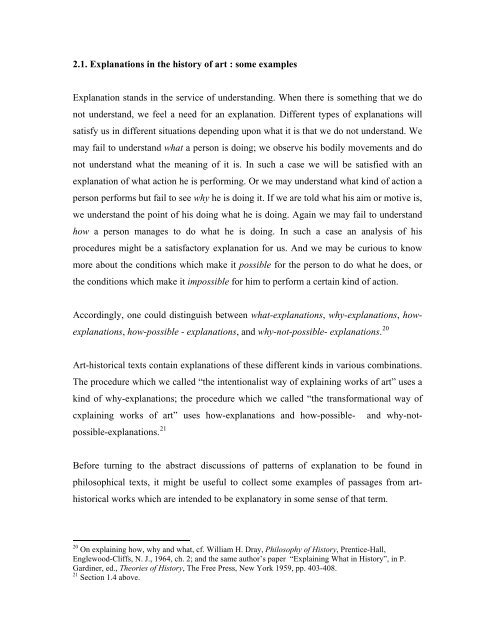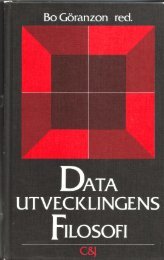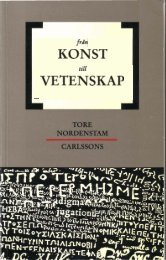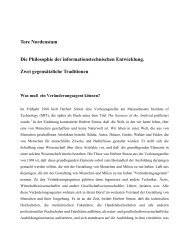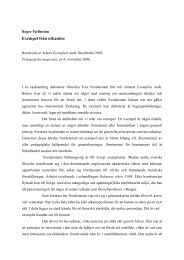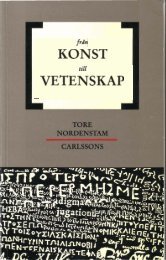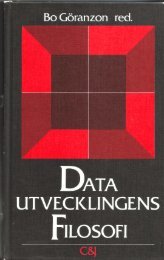tore nordenstam explanation and understanding in the history of art
tore nordenstam explanation and understanding in the history of art
tore nordenstam explanation and understanding in the history of art
You also want an ePaper? Increase the reach of your titles
YUMPU automatically turns print PDFs into web optimized ePapers that Google loves.
2.1. Explanations <strong>in</strong> <strong>the</strong> <strong>history</strong> <strong>of</strong> <strong>art</strong> : some examples<br />
Explanation st<strong>and</strong>s <strong>in</strong> <strong>the</strong> service <strong>of</strong> underst<strong>and</strong><strong>in</strong>g. When <strong>the</strong>re is someth<strong>in</strong>g that we do<br />
not underst<strong>and</strong>, we feel a need for an <strong>explanation</strong>. Different types <strong>of</strong> <strong>explanation</strong>s will<br />
satisfy us <strong>in</strong> different situations depend<strong>in</strong>g upon what it is that we do not underst<strong>and</strong>. We<br />
may fail to underst<strong>and</strong> what a person is do<strong>in</strong>g; we observe his bodily movements <strong>and</strong> do<br />
not underst<strong>and</strong> what <strong>the</strong> mean<strong>in</strong>g <strong>of</strong> it is. In such a case we will be satisfied with an<br />
<strong>explanation</strong> <strong>of</strong> what action he is perform<strong>in</strong>g. Or we may underst<strong>and</strong> what k<strong>in</strong>d <strong>of</strong> action a<br />
person performs but fail to see why he is do<strong>in</strong>g it. If we are told what his aim or motive is,<br />
we underst<strong>and</strong> <strong>the</strong> po<strong>in</strong>t <strong>of</strong> his do<strong>in</strong>g what he is do<strong>in</strong>g. Aga<strong>in</strong> we may fail to underst<strong>and</strong><br />
how a person manages to do what he is do<strong>in</strong>g. In such a case an analysis <strong>of</strong> his<br />
procedures might be a satisfactory <strong>explanation</strong> for us. And we may be curious to know<br />
more about <strong>the</strong> conditions which make it possible for <strong>the</strong> person to do what he does, or<br />
<strong>the</strong> conditions which make it impossible for him to perform a certa<strong>in</strong> k<strong>in</strong>d <strong>of</strong> action.<br />
Accord<strong>in</strong>gly, one could dist<strong>in</strong>guish between what-<strong>explanation</strong>s, why-<strong>explanation</strong>s, how<strong>explanation</strong>s,<br />
how-possible - <strong>explanation</strong>s, <strong>and</strong> why-not-possible- <strong>explanation</strong>s. 20<br />
Art-historical texts conta<strong>in</strong> <strong>explanation</strong>s <strong>of</strong> <strong>the</strong>se different k<strong>in</strong>ds <strong>in</strong> various comb<strong>in</strong>ations.<br />
The procedure which we called “<strong>the</strong> <strong>in</strong>tentionalist way <strong>of</strong> expla<strong>in</strong><strong>in</strong>g works <strong>of</strong> <strong>art</strong>” uses a<br />
k<strong>in</strong>d <strong>of</strong> why-<strong>explanation</strong>s; <strong>the</strong> procedure which we called “<strong>the</strong> transformational way <strong>of</strong><br />
cxpla<strong>in</strong><strong>in</strong>g works <strong>of</strong> <strong>art</strong>” uses how-<strong>explanation</strong>s <strong>and</strong> how-possible- <strong>and</strong> why-not-<br />
possible-<strong>explanation</strong>s. 21<br />
Before turn<strong>in</strong>g to <strong>the</strong> abstract discussions <strong>of</strong> patterns <strong>of</strong> <strong>explanation</strong> to be found <strong>in</strong><br />
philosophical texts, it might be useful to collect some examples <strong>of</strong> passages from <strong>art</strong>historical<br />
works which are <strong>in</strong>tended to be explanatory <strong>in</strong> some sense <strong>of</strong> that term.<br />
20 On expla<strong>in</strong><strong>in</strong>g how, why <strong>and</strong> what, cf. William H. Dray, Philosophy <strong>of</strong> History, Prentice-Hall,<br />
Englewood-Cliffs, N. J., 1964, ch. 2; <strong>and</strong> <strong>the</strong> same author’s paper “Expla<strong>in</strong><strong>in</strong>g What <strong>in</strong> History”, <strong>in</strong> P.<br />
Gard<strong>in</strong>er, ed., Theories <strong>of</strong> History, The Free Press, New York 1959, pp. 403-408.<br />
21 Section 1.4 above.


